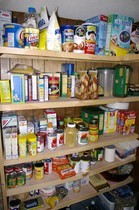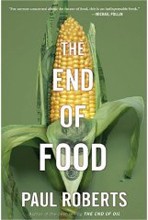 According to the Wall Street Journal, we should all be stockpiling foods to ensure that we won’t run out when store shelves become empty. They claim that stockpiling food is a smart economical move in the event of lean times ahead.
According to the Wall Street Journal, we should all be stockpiling foods to ensure that we won’t run out when store shelves become empty. They claim that stockpiling food is a smart economical move in the event of lean times ahead.
Food prices are already rising here much faster than the returns you are likely to get from keeping your money in a bank or money-market fund. And there are very good reasons to believe prices on the shelves are about to start rising a lot faster. Source
But for those who are accustomed to only buying what you need when you need it, how do you know what kinds of foods to stockpile? And exactly how much should you purchase?
Numerous websites online tell you what kinds of foods you should store for emergencies or in times of crisis.
I found the Bird Flu Manual’s food stockpiling tips very interesting. Of course, this guide is meant to serve you in the case of a pandemic emergency. They recommend:
- A 3-month supply of food for each family member
 Foods that do not require refrigeration
Foods that do not require refrigeration- Foods from all food groups
- Foods that are dried such as fruit and beans
- Whole grain foods such as wheat, rice, and oats
- Dry dairy and egg products
- Edible oils like olive, canola, and sunflower oil
- Nuts (check for a 3-month or more expiration date)
- Canned foods such as meats, vegetables, and fruit
- Enough water for each family member
Since the reason to store foods right now is not due to a pandemic, nor is this a disaster type of emergency, I think it is okay to stock up on frozen meats as well. (I told you that chest freezer could come in handy!)
In addition to knowing which foods to store, you also need to know where and how to store them. Buying large quantities of food means that you may find yourself with limited storage space. In addition, you may need to transfer some of your items into airtight packaging. Some ideas:
- Plastic food storage containers are needed to keep your grain-based products dry and pest-free. Tupperware and Rubbermaid are popular brands, but seldom hold more than 5 to 10 pounds of food.
Large food storage containers will hold your large quantities of rice and flour. Some of the most practical are the larger 10+ gallon bulk food containers that are airtight, and have wheels.
You may need to add a second pantry area to your basement or garage. This could mean adding cabinets and shelving to create additional food storage space.
 To stockpile foods, you don’t have to run right out and spend your entire stimulus rebate check on rice, flour, and canned goods. Instead, you can might want to spend an extra $25-$50 per week on food until your pantry and shelves are full.
To stockpile foods, you don’t have to run right out and spend your entire stimulus rebate check on rice, flour, and canned goods. Instead, you can might want to spend an extra $25-$50 per week on food until your pantry and shelves are full.
Then again, some view the stockpiling food in anticipation of rising food prices as a self-fulfilling prophecy. According to Bill Knudson, a Department of Agricultural Economics professor at Michigan State University, "The easiest way to raise food prices is if everybody went out and stockpiled food."



